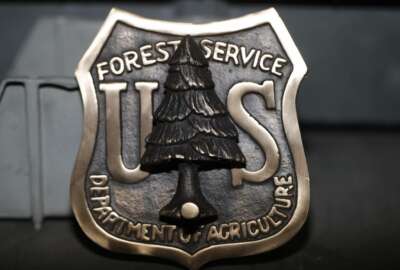
The Agriculture Department promotes new ways to manage and use a very old resource
You would think everything wood can be used for has been thought of. But wood, considered a renewable resource, has a lot of life. The Agriculture Department is...
You would think everything wood can be used for has been thought of. But wood, considered a renewable resource, has a lot of life. The Agriculture Department is running a competitive grant program to come up with new ways to manage, promote and use wood. For the details, the Federal Drive with Tom Temin spoke with Brian Brashaw, the Forest Service’s assistant director for Wood Innovations.
Interview transcript:
Tom Temin And you are speaking to us from the forested areas of the middle of the country too, aren’t you?
Brian Brashaw I am. I am based out of Duluth, Minnesota, but I worked for a Washington, D.C. National Office.
Tom Temin All right. So tell us about this grant program. First of all, what are you specifically trying to do here for, I guess, wood that is grown for the purpose of being harvested?
Brian Brashaw We know that having markets for wood products really helps landowners manage their forests. Having financial impact and financial connections really supports that forest management in its federal lands, state lands, tribal lands and private lands. So our grant programs are really geared to support the development of markets for wood products and for renewable wood energy.
Tom Temin And outside of home construction, which I guess, uses a lot of pine. Isn’t that what 2×4’s and stuff are made from and plywood? And then, I guess, oak is the other big one. What are the major woods that are used for various products in the country?
Brian Brashaw We have a really robust hardwood lumber industry in the country that really supports industrial applications, things like railroad ties and pallets and crating, and then furniture and flooring and all the things that decorate our homes. The softwood industry is really across the country, the U.S. South, the Pacific Northwest, and then in the Northeast and in lakes states. Most of that lumber goes into construction applications for residential building products, and a new emerging building material called cross laminated timber that can be used for taller buildings. And then the third, really part of the wood products sector, is engineered panel products. So those are things like oriented strand board or plywood, that you mentioned or referenced.
Tom Temin All right, interesting. So this grant program is going to what types of organizations? What are you looking to develop or promote here through these grants?
Brian Brashaw Yeah, we’re really trying to support markets for wood products, new markets, innovative markets, getting wood in places that it hasn’t been before. So the kinds of folks that are interested and available to apply are for profits, not for profits, states, tribes, it’s really a wide set of applications that can be received for these two programs. There’s the Wood Innovations Program, and then the second one is the Community Wood Facilities Grant Program.
Tom Temin Yeah, What is a community wood facility? Sounds like a fancy word for forest.
Brian Brashaw Well, it’s our community wood energy. Our community Wood facilities program really has to emphasis. One, is these are shovel ready projects that can support expansion or new facilities. It really has a primary emphasis on small scale community wood energy. So we’re talking about small campus, maybe a school campus that might be heated using wood for heat, which is a very thermal user, very efficient use for wood. And then, we also have the ability to invest in facilities, innovative wood products facilities, that might be things like cross laminated timber, this large, thick panel that can be used to construct taller buildings. Or other innovative wood products, like biochar or other new cellulose based nanomaterials that might be coming to the marketplace. So that’s what the Community Wood program is really all about, is to support renewable wood energy facilities that are going to produce heat at a district or small scale. And then also, innovative wood products, processing facilities and equipment.
Tom Temin And just a question on that wood for heating. Having spent some time in New England many years ago, everybody had a wood stove. It was kind of a fad that they came back into existence, sometime around the late 1960s, early 1970s. But they do produce smoke, and it’s kind of an old fashioned way in this age of solar this and battery that. So what are the issues with wood as a heating fuel these days?
Brian Brashaw So what I would say, is that our renewable wood energy sector, these aren’t your grandfather’s old woodstoves. These are clean, efficient, safe burning technologies that really are available for installation for homes, but also for larger scale applications. And that’s where it really is an important market outlet for wood products that don’t have another home. So these are clean, efficient and highly regulated products that we’re supporting.
Tom Temin Sounds like that particular application could boost, maybe steam production again, say in heating or that type of thing.
Brian Brashaw It does create. There’s different ways to create heat, and steam is certainly one of those options.
Tom Temin We’re speaking with Brian Brashaw. He’s assistant director for Wood Innovations at the U.S. Forest Service. And so the grantees will produce what? Ideas? What do we get out of these grants to these various organizations?
Brian Brashaw So our two grant programs, really support a wide range of applications that help us bring wood products to markets. So in our wood innovation grants, those are typically grants that are about $300,000. And those really support the establishment of wood energy teams within states, innovative wood products teams, kind of a cross-sector that can focus on the market development within a state. But we’re also providing funding to support introduction of new engineered wood products like mass timber or cross laminated timber. Think of that as to buy construction lumber that’s flat laminated into thick panels. We’ll provide and support engineering or feasibility analysis for tall buildings. So for instance, one of the projects that we supported with the Wood Innovation grant was the University of Idaho’s new mass timber basketball arena, just an incredible showcase for the value of wood products in a university setting. The tallest building in the world is 25 stories.
Tom Temin That was my next question.
Brian Brashaw 19 stories is, it’s in Milwaukee, Wisconsin. It’s known as the Ascent building. And we supported that early stage front-end design, engineering and feasibility, which leads to, in that case, tens or hundreds of millions of dollars of investments as projects go forward. There’s just a whole range of projects from biochar market development or standard development or equipment purchases that are eligible under the Wood Innovation Grants program.
Tom Temin And what about fire performance in tall buildings? Because I imagine if that takes hold, that’s the first question people will have.
Brian Brashaw It certainly is. And a large cross-section or large members. So this might be large columns or beams that are horizontal. And then you’ve got your floor systems, which also becomes the ceiling of the floor above. These large cross-section members perform very, very well. Wood, as it burns, creates char. And as wood chars, that really slows down the combustion. So wood burns predictably. The Forest Service and our National Laboratory, which is the Forest Products Laboratory in Madison, Wisconsin, has really been a scientific backbone working with many, many partners to look at building codes, to look at fire codes, to engage in these kinds of things. And I can tell you, that tall building in Milwaukee, the Milwaukee Fire Department was one of the first partners that was engaged in helping to assess and understand how these new building materials fit into the in the marketplace and into safety and into codes.
Tom Temin Well, the fire that burned the White House in 1812 charred some of the main beams, yet they lasted in place until about 1945, when they had to clear out and finally rebuild the place. So we do have that history there. And this is a really off the wall question. Any interest from what used to be known as Detroit, collectively, will you ever see, maybe, wooden cars again? Some woody sided wagons?
Brian Brashaw Henry Ford was the saw miller way back in the day, and the wood products were there. There has been, over time, wood fiber composites that have been utilized in vehicles. And I do think that those kinds of unique, innovative applications are still coming. I think there’s still quite a bit of work in some of the sectors in the automotive industry to incorporate wood, because it is such a strong, lightweight material that offers a lot of benefits.
Tom Temin And finally, the deadline for people wanting grants.
Brian Brashaw So our application deadline, we have $24 million available for the Wood Innovation Grant program. We have $17 million available for the Community Wood, which is really the Facilities Grant program. Both of those applications close on March 23 of next month.
Copyright © 2025 Federal News Network. All rights reserved. This website is not intended for users located within the European Economic Area.
Tom Temin is host of the Federal Drive and has been providing insight on federal technology and management issues for more than 30 years.
Follow @tteminWFED




